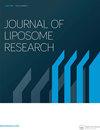A comparative study of sensitizers and liposome composition in radiation-induced controlled drug release for cancer therapy.
IF 4.3
4区 医学
Q2 BIOCHEMISTRY & MOLECULAR BIOLOGY
引用次数: 0
Abstract
This study investigates drug-loaded liposomes designed for controlled release under ionizing radiation to refine cancer treatment precision. Liposomes as carriers enable targeted chemotherapy delivery, reducing healthy tissue damage risk. Liposomes containing poly- or mono-unsaturated fatty acids and various sensitizing agents were assessed for responsiveness to UV light and γ photon irradiation including rose bengal (RB), protoporphyrin IX (PPIX), verteporfin (VP), cercosporin (CERC) and hypericin (HYP). Carboxyfluorescein (CF) was used as a surrogate for drug release measurements. VP and PPIX induced rapid drug release and lipid peroxidation under UV light, while RB prompted quick drug release under UV light and a modest immediate release under γ irradiation, eventually reaching full release a few hours after irradiation, demonstrating dose-dependent effects. Smaller liposomes displayed accelerated release, emphasizing size-dependent kinetics. In vitro analyses evaluated radiosensitizing effects of RB-loaded liposomes. Clonogenic assays indicated that RB-filled liposomes had minimal direct radiobiological effects but increased indirect radiation damage, as shown by the curvature of the cell survival curve. Our study sheds light on factors influencing liposomal drug release under ionizing radiation, spotlighting RB as a promising radiosensitizer requiring further investigation for cancer therapy potential.辐射诱导癌症治疗药物控释中敏化剂和脂质体成分的比较研究。
这项研究调查了为在电离辐射下控制释放而设计的载药脂质体,以提高癌症治疗的精确度。脂质体作为载体可实现靶向化疗给药,降低健康组织受损的风险。研究人员评估了含有多元或单不饱和脂肪酸和各种增敏剂的脂质体对紫外线和γ光子照射的反应性,包括玫瑰红(RB)、原卟啉IX(PPIX)、verteporfin(VP)、槲皮素(CERC)和金丝桃素(HYP)。羧基荧光素(CF)被用作药物释放测量的替代物。在紫外线照射下,VP 和 PPIX 可诱导药物快速释放和脂质过氧化,而 RB 可促使药物在紫外线照射下快速释放,并在γ 照射下立即适度释放,最终在照射几小时后达到完全释放,显示出剂量依赖性效应。较小的脂质体显示出加速释放,强调了大小依赖性动力学。体外分析评估了负载 RB 的脂质体的放射增敏效应。克隆生成试验表明,填充 RB 的脂质体对辐射生物学的直接影响极小,但会增加间接辐射损伤,细胞存活率曲线的弯曲就表明了这一点。我们的研究揭示了影响电离辐射下脂质体药物释放的因素,并强调 RB 是一种很有前途的放射增敏剂,需要进一步研究其治疗癌症的潜力。
本文章由计算机程序翻译,如有差异,请以英文原文为准。
求助全文
约1分钟内获得全文
求助全文
来源期刊

Journal of Liposome Research
生物-生化与分子生物学
CiteScore
10.50
自引率
2.30%
发文量
24
审稿时长
3 months
期刊介绍:
The Journal of Liposome Research aims to publish original, high-quality, peer-reviewed research on the topic of liposomes and related systems, lipid-based delivery systems, lipid biology, and both synthetic and physical lipid chemistry. Reviews and commentaries or editorials are generally solicited and are editorially reviewed. The Journal also publishes abstracts and conference proceedings including those from the International Liposome Society.
The scope of the Journal includes:
Formulation and characterisation of systems
Formulation engineering of systems
Synthetic and physical lipid chemistry
Lipid Biology
Biomembranes
Vaccines
Emerging technologies and systems related to liposomes and vesicle type systems
Developmental methodologies and new analytical techniques pertaining to the general area
Pharmacokinetics, pharmacodynamics and biodistribution of systems
Clinical applications.
The Journal also publishes Special Issues focusing on particular topics and themes within the general scope of the Journal.
 求助内容:
求助内容: 应助结果提醒方式:
应助结果提醒方式:


